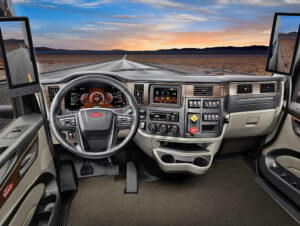Sales of new Class 8 trucks fell further behind last year’s pace in March, according to data received from Wards Intelligence, just as analysts expected.
Manufacturers reported sales of 19,658 trucks in March — 11.6% better than February’s 17,619 but 20.9% behind sales in March 2023.
For the first quarter of 2024, reports show 55,871 total Class 8 trucks sold, a pace that is now 13.9% behind the same three months of 2023.
While analysts have predicted a slowdown in truck sales, especially in the second half of 2024, March sales might be considered defiantly strong. If the problem of persistent low freight rates is caused by too many trucks (indicating an overcapacity for available loads), and the answer is fewer trucks, then why is the industry stubbornly buying more trucks?
Kenny Vieth, president and senior analyst at ACT Research says private fleets are driving the buying. “Our answer over the past year has been private fleets, who have reclaimed freight from load boards and taken market share from for-hire markets,” he said.
Companies that haul their own products aren’t as susceptible to market variations as for-hire fleets, and they can better estimate their costs for moving their products to market. Unfortunately, that means there are fewer loads posted for carriers to haul — resulting in increased competition for the loads that remain. Additionally, private fleets that seek backhauls are a part of the competition.
The U.S. Environmental Protection Agency (EPA) is another factor — specifically, the next round of EPA mandates that will go into effect with the 2027 model year. New technology will be used to further reduce emissions of pollutants and greenhouse gases and to increase fuel mileage.
When new technology was introduced with the 2007 models, a massive pre-buy of 2005 and 2006 models occurred as carriers, were worried about the costs and reliability of 2007 trucks, stocked their fleets with earlier-year models.
To help alleviate similar concerns with the 2027 models, the government mandated that manufacturers provide more warranty coverage for problems that may arise. In doing this, however, another incentive to pre-buy was created — cost.
“Current estimates are putting the Day 1 cost of the mandate, inclusive of taxes, at around $30k per Class 8 unit,” Vieth said. “Most of that added cost is tied to the warranty and useful life extensions.”
Pre-buying is undoubtedly responsible, in part, for the stubbornly strong orders for new trucks, too. On the North American market, 18,200 orders were placed for new Class 8 equipment in March, according to FTR Transportation Intelligence. That’s down 34% from February order numbers but only 4% lower than March 2023 numbers. Seasonally, orders usually fall off in March, so the decline was not unexpected.
“Order levels in March were below the historical average but remained in line with seasonal trends,” said Eric Starks, FTR’s chairman of the board. “Demand is not declining rapidly, but neither is the market doing significantly better than replacement level demand.”
North American order numbers for Class 8 trucks are also impacted by the “nearshoring” happening in Mexico. Companies are moving manufacturing and warehousing operations from Asia and other points to take advantage of low-cost labor and reduce shipping cost and delays to U.S. markets. Portions of Northern Mexico are booming with construction of these new facilities.
On the used truck market, sales remained strong in March, according to ACT’s latest State of the Industry: U.S. Classes 3-8 Used Trucks. The report indicates the number of units moved in March increased by 4% over February numbers, even as sales were 4% lower than in March 2023.
The better news for potential buyers is that trucks sold in March were, on average, 20% cheaper than they were a year ago, with fewer miles on the odometer and less age.
Those in the industry that rely on used equipment will find better deals these days, but those that must borrow to finance those deals will find that interest rates are higher and lenders are much more selective about approving loans.
A recent release from Commercial Truck Trader revealed interesting information about today’s truck buyer. The company lists nearly 300,000 trucks and trailers for sale daily; about 30,000 of those are Class 8 vehicles.
According to the release, today’s commercial vehicle buyer is younger, with 68% of the reported demographic being from Generation X and Millennials (1965-1980). Additionally, 32.5% are women. A breakdown of Class 8 buyers compared with other classes wasn’t available, but Charles Bowles, director of commercial truck OEM and strategic Initiatives, indicated a similar trend in that group.
“In other words, the average truck buyer and driver is becoming younger and more diverse. “This is really a reflection of how the industry has had to respond to driver shortages by appealing to a broader base,” Bowles said.
Of the new Class 8 trucks sold on the U.S. market in March, Freightliner led the way, reporting sales of 7,214, followed by Kenworth at 3,142, Peterbilt at 3,140, Volvo at 2,016, International at 1,945, Mack at 1,388 and Western Star at 806. Hino reported sales of 7 Class 8 units, all day cabs.
Although all manufacturers together reported 20.9% lower sales in March than in February, the two PACCAR companies had the smallest declines, while Western Star actually gained sales.
For the year to date, Freightliner’s 21,576 sold was good for 38.6% of new, Class 8 sales on the U.S. market. Peterbilt’s 8,750 claimed 15.7% while Kenworth’s 8,419 was good for 15.1% of the market. International reported first quarter sales of 5,654 to take 10.1%, followed by Volvo with 5,581 at an even 10%. Mack was responsible for 3,348 trucks or 6.0%, while Western Star’s 2,521 held 4.5% of sales.
Kenworth and Peterbilt have increased their market shares from last year by 1.5% and 2.2%, respectively, perhaps due to more private fleet buying. Volvo and Western Star have also gained market share.
Freight rates are expected to begin rising slowly in the second half of the year as truck buying slows, but as pre-buying increases, the reduction in capacity will be slowed.
Cliff Abbott is an experienced commercial vehicle driver and owner-operator who still holds a CDL in his home state of Alabama. In nearly 40 years in trucking, he’s been an instructor and trainer and has managed safety and recruiting operations for several carriers. Having never lost his love of the road, Cliff has written a book and hundreds of songs and has been writing for The Trucker for more than a decade.








